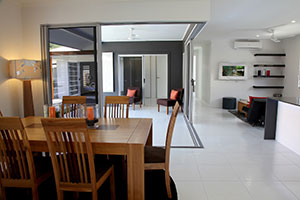 The coronavirus pandemic has highlighted the shortcomings in many house designs as people have spent more time at home, whether working from home, in lockdown, or homeschooling.
The coronavirus pandemic has highlighted the shortcomings in many house designs as people have spent more time at home, whether working from home, in lockdown, or homeschooling.
Over time, a single space in a house might need to work as a home office, teenage retreat, spare room for visiting relatives; or a bedroom for an ageing grandparent. There will also be periods in the lifetime of the house where it will need to be adaptable to changed capabilities in the family. For example, someone in the family may be on crutches, a toddler may be learning to walk, or as family members get older, they may have reduced mobility or vision. In multigenerational households, these could all be happening at the same time!
A Universally Designed house is adaptable and flexible and accommodates the changing needs of the inhabitants over their lifetime without the need for major changes. There are a number of smaller renovations based on the principles of Universal Design that can help make a house more adaptable than your average home and will better serve a family’s needs both now and in the future.
1. Entries and exits
A flat surface for parking can make life so much easier whether you are trying to get babies or young kids into car seats or prams; an older adult into the vehicle; or need to accommodate someone using a wheelchair or walker. Access should cater for all weather, have suitable lighting, have enough space to get in and out of vehicles comfortably. It should be constructed from non-slip surfaces that contrast to the areas around it. Once you have everyone in or out of the car, getting into the house is the next step. Wide opening doors and a no-step entry can help prevent trips and falls.
2. Wide corridors and open-plan spaces
Once inside the house, wide internal corridors of at least one metre wide on the ground floor make it easier to move around. Not only does this make a house look more spacious, but it makes it easier to maneuver prams and wheelchairs and to move furniture around. It is also a good idea to avoid long corridors. This is a more efficient use of space and can cut down on building costs.
3. Door hardware
Whether it’s kitchen cupboards or door handles, they are some of the quickest and cheapest ways to modernise a house. There are also plenty of standard options to choose from that are easier to use for young children or those with limited or reduced hand function. For example, lever-action door handles are far easier to use than doorknobs that require a gripping and twisting action.
4. Flooring
The choice of flooring in a house can make life a lot easier. Non-carpet options like non-slip tiles or hardwood floors are great for high traffic areas of the home. They are easy to keep clean if you have pets and young children and make it easy for someone in a wheelchair to move around. If you prefer carpets in bedrooms, then soft carpets that are not too thick will make it easier for someone using a walker, crutches or wheelchair.
5. Lighting
It’s important to install extra lighting where necessary and switches at a height where someone in a wheelchair or a child can easily reach them. Rocker style light switches have clean architectural lines that integrate seamlessly with existing structures and are easier to use if you have arthritis. Automatic motion sensor switches and skirting lighting are also good alternatives.
So how do you pay for these renovations?
Refinancing to renovate is the most popular reason for refinancing and can be a great way to add value to your property. If you’re considering this as an option, here are some things to consider:
Get a valuation done on your home. This will help you work out how much you can borrow. The Loan Value Ratio (LVR) is the value of what you are borrowing as a percentage of your property value that is being used as security for the loan. The lower the LVR, the lower the risk is to the lender.
Look at the sale prices of houses in your area and work out the median property value. It’s a good idea to spend no more than 10% of this value on a renovation, otherwise, you risk over-capitalising.
Use a mortgage calculator or book a free consult with a mortgage broker, to help you figure out the cost of repayments as well as help you to dot all the ‘i’s’ and cross all the ‘t’s’.
Contact the friendly team at ActonLendingSolutions to find out more about refinancing to renovate.
More articles like this
The Bunnings effect and renovation during COVID
10 Tips for updating your laundry
Kitchens – planning with tomorrow in mind
Home renovations that add real value


